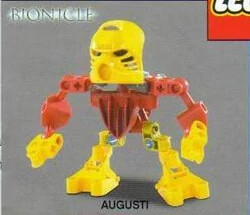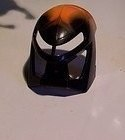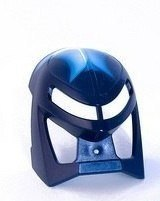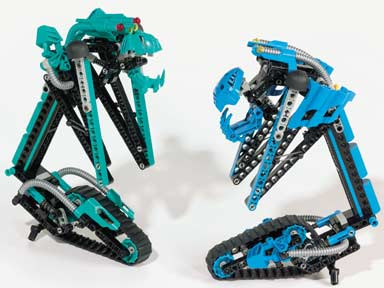No idea! Definitely needs a bigger sample size for research. I’m not sure what my blue Huna would have originated from, but the copper masks were produced in 2001, later than the power pack. At that point the Bohrok were well on their way.
I will go through some of my masks to add to the sample size then.
UPDATE: I have already found something. The silver and golden masks found in mask packs of 2002 have an extra 5-digit number in them when compared to their 2001 counterparts.
2001 have - the designer code (3-LT etc.); copyright symbol © ; design ID (identity of mold/shape) and the mold position number (e.g. 2-02).
2002 have - the designer code (3-LT etc.); copyright symbol © ; design ID (identity of mold/shape) and the mold position number (e.g. 2-02); unknown 5-digit number (43095=Hau, 43096=Miru).
Note that this does not correspond to element ID (combination of shape and color), which should be a 7-digit code.
At least in case of Miru, the copyright symbol is sllightly smaller in gold/silver variant and these also lack the line under the chin of the previous iterations I will add pictures later if I get to it).
Looking at my own collection:
Kakama:
- Both my gold and dark orange one says 3-02. The dark orange has wedges on the insides of the cheeks and forehead that are not present on the gold one.
Pakari:
- Light blue 2-01, gold 1-01, orange 2-01. No discernible difference.
Kaukau:
- Trans-Blue 1-01, Gold 4-01, Silver 1-01. I’d be rather surprised if these were different.
Akaku:
- Ditto. 3-02 Silver, 2-02 Gold.
Hau:
- Infected: Text at the bottom ridge, TINY! 4-01.
- Gold: 4-02. The same text is still present, however there is more text above the attachement point. 43095… My first thought was 42031 which is the Chrome Hau’s but… no. My chrome Hau is the same as the infected one; 2-02.
To complete the set, my gold Miru is 3-02. And yes, I see the 43096 too.
![]() Is this why we don’t have IDs for them? Because they’re using a new design ID? That’s huge! Why do they do this? I don’t see any on the other 4 though. If it has to do with material, why don’t the copper masks, trans-Ruru, and the neon green Miru use other IDs?
Is this why we don’t have IDs for them? Because they’re using a new design ID? That’s huge! Why do they do this? I don’t see any on the other 4 though. If it has to do with material, why don’t the copper masks, trans-Ruru, and the neon green Miru use other IDs?
Curious if a comparison between the NA and EU copper masks could bring anything.
Wait, so the other gold/silver masks outside of Hau and Miru don’t have these extra numbers?
I recall the lines you mention in the Kakama comparison - must be similar difference to the Miru chin line I mentioned.
So the mold position is irrelevant it seems so far.
Yeah. I think the mold as a whole would have been updated.
Seems like for most there are 4 positions, just like the Hau Nuva, and 2 molds, as seen with the Kakama, Akaku, and Hau. The differences are happening within the same mold-position combo as is the case with my Kakama.
Edit:
So… the whole prototype thing… I have to kinda assume that, since the molds did change, those old ones with the codes on front have to be using these IDs too… Why would they be doing dark grey Ruru before deciding on going with a dark grey Ruru?
But then, that doesn’t line up with the Sand Tarakava. Why is the prototype of the Tarakava using a mask that is newer than the masks worn by the final Tarakava? That doesn’t make sense.
There’s also the fact that the Toa Mata limbs in grey appear earlier, alongside all the other colors of them…
To add even more confusion to it – We have seen the yellow Hau with the code on front – in 2003! (Probably reusing an old prototype though.)

And again, where is the trans-blue Rau?
Also, when were the marbled Miru produced? 


Some big news again over at the research topic:
Looks a lot like these are straight-up prototypes rather than finalized parts.
Yep, they are, I think all of them. It is fascinating seeing that some of the masks predicted to exist in the final form (based on the sheet) also exist in prototype form.
Also I posed this question in the other topic: Is that Mahiki bright blue (23) or violet (110)? It seems too vibrant of a color to be just blue.
Looks like just regular mata blue to me
Looking on the inside of those dual mold Miru would tell us if they were made before 2002 or after based on the info we have gathered in this topic. But that would be a manner of contacting the owners of those masks.
I was thinking the same thing. It looks too blue and dark though, but you never know with violets on camera. Reminds me of dark blue-violet / Dark Royal Blue.
The white Kaukau, yellow kakama, purple voodoo arm, light grey “spur”, and teal axestand out to me as things we don’t have IDs for. Wonder how the axe compares to the Lewa prototype. The dark grey Hau as well, given that wouldn’t be a thing until 03, and this one has a code.
Speaking of the IDs, I’m thinking that the code-on-front masks have to be the first (or second?) iteration of the mold for the Ruru and Hau to make sense – at least if the material of those is the usual (which would mean they’re molded, which obviously means they have to have had molds).
There’s also the fact that among the initial Toa Mata parts are Kopaka’s and Onua’s limbs in the greys, and that’s before any mask…
I think that on a smaller scale, they’re not all that useful for determining when decisions were made. I figure a lot of these were added in several bulk orders that may not have been entered in exact chronological order of when they were made, or something along those lines. I.e. not an organized queue.
Also, some instruction manuals come before the parts that they include, such those of the HF 2.0 heroes, or the Toa Mata’s. They were probably revised, just like the molds?
Asked Black Six about the Miru; time to wait and see. Not sure if he still has any.
Edit: Nope, he doesn’t have them anymore.
Thanks for the effort. I think all of the parts on the newest picture are prototypes (not final molds).
From the ones I can tell for sure:
orange Matatu
white Huna
black Huna
dark gray Rau
dark gray Hau
light gray Ruru
yellow Kakama
medium blue Pakari
tan Miru
teal axe
gray foot addition
purple toa arm
The rest I can’t definitely say I see the giveaway signs of prototype parts (from this specific picture), but considering those are in minority, it is safe to assume all of them are indeed prototypes and not final molds.

Another part we can’t verify the state of, nor have an ID for: Teal Onua claw. (might be painted given some of the other parts here).
Was just doing my once every few months BZP check and fell down the rabbit hole a bit and ended up here.
This write-up is incredible, it’s amazing to see things like this still being done after 20 years, and reading about the possible origins of the EU Misprints was great. Props to everyone involved.
Has anyone had any follow up regarding the Medium Blue Kakama, or the new set of 5? I got in touch with the guy who had two of the Kakamas, one was sold, one not for sale. Came with a random used Toa purchase, no further follow up with the previous owner. Located in Denmark. Whoever bought it must have paid a lot, do we know who it was?
Doesn’t seem like there’s been any further follow up on the 5 piece either. Guy has Twitter DMs off but I DMed on Insta, no response as of yet. Seems like it’s always the same story much like the Brown Komau, got it in a random lot, friend said they got it from a mask pack etc. I’m dubbing them the Infinity Masks… rare, beautiful… and one person probably shouldn’t own them all 
Welcome to the rabbit hole!
There are three medium blue Kakama owned by two people - though based on your information, now there are three owners, one for each mask.
These things, unsurpsiringly, come almost exclusively from Europe. Denmark and Sweden seem to be most common sources.
It’s impressive how much has been uncovered in a very short time. Also happy that I might’ve been right all along about the peach ruru
Makes sense, not too uncommon to move to another Scandinavian country for work, assuming these are “souvenirs” from former LEGO employees.
@Wolk has put together a much more complete and unified essay based on the same data that I used that I think pulls together the details in a more satisfying way. Check it out here: The Original Role of the Ruru & Matatu.pdf - Google Drive
This may have already been said somewhere, but… what are the odds that this late decision was somehow related to these same two masks being mistakenly released in the Toa colours?
I have some insight as to the “product versions” of the Toa Mata which may or may not be useful towards figuring out what the six additional Tohunga sets would’ve been.
A while ago I assembled a comprehensive list of every version of the Toa Mata ever released, for collection purposes:
The 7-digit item number is the one located right above or below the barcode. For every “type” there is also a unique 7-digit item number denoting that specific release of the rotating sleeve.
Two things are particularly curious here:
-
The six International and six American releases with CDs occupy twelve consecutive item numbers; this isn’t the case for any of the other releases.
-
There was an additional release for Pohatu, Onua and Gali only that lacked Portuguese copy on the packaging. These were produced towards the end of 2001 (but not in 2002 like many of the other releases) in Europe and then distributed in North America.
All of these have been verified with photos of current and sold listings in the 100s if not 1000s.
I also have the six non-McDonald’s Tohunga sealed and will inspect them to verify their item numbers.
